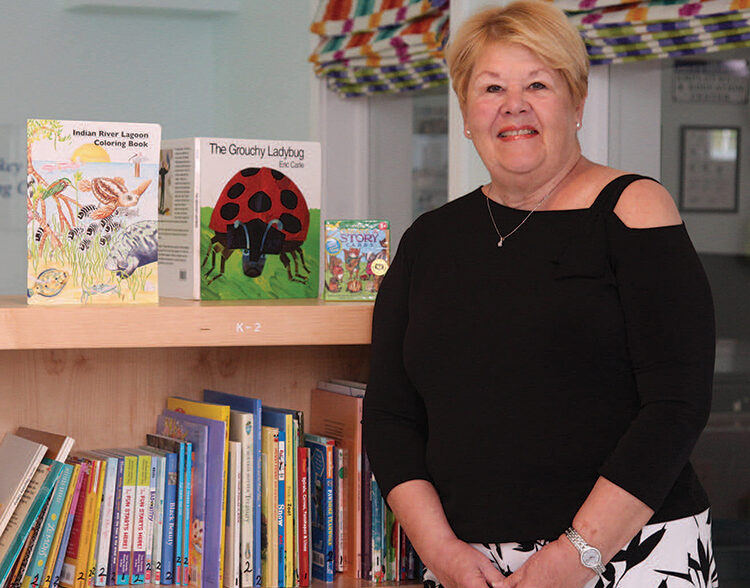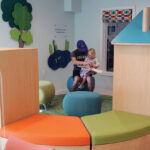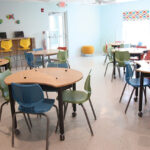
Thanks to the support of the community, the Hope for Families Center was able to open the newly constructed Flaherty Reading Resource Center on the campus of the nonprofit’s homeless family shelter during the pandemic, when it was greatly needed.
Diana Grossi, HFC executive director/CEO, said that when she first came onboard, her background as an educator helped her to zero in on ways to provide more support for the children living there with their families. After determining that what was most needed was a quiet place where children could immerse themselves in the world of literacy, everything began to fall in place.
“That’s the purpose of the room, a place for the children to do homework and school projects and just to come in and be quiet,” said Grossi, who will retire from the position at the end of June.
Recognizing the truth of the quote by Margaret Fuller, “Today a reader, tomorrow a leader,” their hope is to break the cycle of generational poverty by promoting literacy at an early age.
In this way, families might turn the page to a new chapter in their lives, a goal that perfectly aligns with the mission of HFC to “provide opportunities for homeless families to end homelessness by achieving self-sufficiency through education, living wages and permanent housing.”
According to Dr. William Cooney, HFC board president, more than 60 percent of the people living at HFC are children.
Prior to the construction of the Reading Center, HFC had just one central living room area where people worked or conducted job searches, watched television or generally congregated. What was needed was a quiet place where children and parents could read together.
“The children were behind, as were the parents quite honestly, in their reading skills,” Cooney explained.
Providentially, Terry Flaherty was searching for a cause in which to donate funds left in trust by her late husband, Joseph V. Flaherty, that she felt would be meaningful to him.
“My husband was an avid reader, so the reading center was a perfect choice. I was just so impressed with what they were doing [at HFC] and how they were doing it,” said Flaherty.
What she appreciated is that residents are expected to follow a plan to get back on their feet.
The Flaherty Family Foundation donation, along with those from other notable local philanthropists, covered the bulk of the construction, and the Hill Group took on the project at cost.
“We’ve had a lot of help all the way along the road,” said Grossi. She noted that they had applied for grants from various local funding organizations, including Quail Valley Charities, John’s Island Foundation and John’s Island Community Service League, to help fund the construction, furnishings, computers, books and a part-time educator to work with the children in the evenings.
Grossi said they also received design guidance on decorating the reading room from Coastal Comforts that included pops of cheerful colors and carryall-like dividers for computer stations and safe distancing.
Children can now often be found curled up in the Mickey Cooney Young Children’s Reading Corner, a cozy space with an interactive “reading” tree that features bugs, rabbits, a hedgehog and frogs.
While staying at the shelter, parents are required to complete “productive hours,” and reading and working with their children count toward that requirement.
“We want them to be productive. Our goal is to also educate the parents on how to follow their children in school,” says Grossi, noting that when parents first arrive at HFC, their children’s education isn’t always their priority.
“We want it to become a priority. We want to stabilize the children along with the family and get the parents invested in their child’s education,” said Grossi. “Hopefully, down the road, we’re going to be able to build a volunteer program. Right now, people are a little reluctant to come in and work with the children. That’s the goal, to develop a mentoring and volunteer program for the children as well as adults.”
She said that research has shown that a child’s success in school and in life correlates to independent reading.
“The more children read, the better the chance they will have in school. Hopefully, we’ll be able to break this cycle of homelessness. Our job, our desire, is to promote the love of reading. That’s why we’re hoping to focus on books that are Accelerated Reader books.”
Flaherty said that she could only imagine the adjustments needed by families coming to the Hope for Families Center after often horrific circumstances, likening it to being exposed to another world.
“It’s not only comfort, food and lodging, but it’s playtime. They have it all in a controlled but magnetic way of getting the children involved no matter what ages they are, and that’s a big job,” said Flaherty.
The Hope for Families Center is seeking donations to help fill the shelves with books, noting that funding will enable staff to select age-appropriate Accelerated Reader books that are supported by the reading programs at Indian River County schools.
According to Cooney, the HFC provides services to about 130 families a year, although Treasure Coast Homeless Coalition statistics indicate that there are likely another 100 families that would benefit from the support, education, job counseling, meals and housing they provide.
To expand programs and services, HFC partners with the Source, Boys and Girls Clubs, Childcare Resource Center and United Against Poverty to supplement childcare, job training and education.
For more information, visit hopeforfamiliescenter.org.
Photos provided






